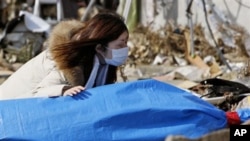As the world anxiously watches Japan's nuclear crisis, the death toll from earthquake and tsunami that ravaged the country one week ago is still rising, and many hundreds of thousands remain homeless.
Japanese police said Saturday they have confirmed the death of 7,300 people, but nearly 11,000 more are still missing. The earthquake and especially the tsunami that followed minutes later wiped out entire communities in northeastern Japan on March 11.
Emergency crews have been unable to search the entire disaster zone thoroughly, but the hope of finding survivors is now nearly gone. In many ways, emergency crews' focus has now shifted to trying to care for survivors. Nearly a half-million people have been driven out of their homes - either by the natural disasters or the government's mandatory evacuation order for those living near the crippled Fukushima nuclear plant.
Gasoline shortages and damaged infrastructure have greatly hobbled relief efforts, and many shelters have at times run out of medical supplies, food and other essentials. Freezing temperatures across the northeast have put an extra strain on elderly and sick evacuees.
Aircraft from a U.S. naval flotilla off Japan's east coast of Japan have been dropping food and supplies at isolated shelters, as well as watching for anyone swept out to sea who may still be alive. The commander of the U.S. 7th Fleet, Vice Admiral Scott Van Buskirk, said in a Facebook message Friday that the enormity of the disaster and "the reality of radiological contamination" complicates planning and execution.
Reports earlier Saturday that a man had been found alive in a collapsed home in in Miyagi prefecture turned out to be misleading. He had been staying at a shelter since the earthquake, but fell unconscious when he returned to his home Friday to check on damage.
Some information for this report was provided by AP and AFP.










